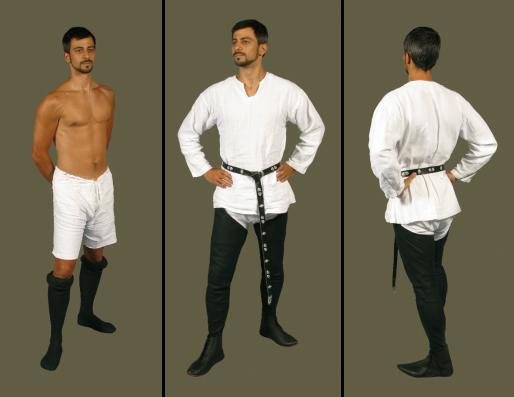Thursday, January 27, 2011
To brogue or not to brogue
So, I did a little digging into what everyone was saying about everyone else's books and there seems to be a split between love or hate - and very little in between. There are those who swoon at a hero's scottish brogue and those who feel as if their teeth are being scraped with chalk. Some suggestions to "tell" the brogue instead of "show" it
e.g. "I can't say," Rowan said with a husky burr.
As opposed to "I canna say," Rowan said.
In Betrayed, I use a good amount of brogue, although I go easy on the main characters who occupy most of the dialogue to make the reading easier. My heroine is English, so she's not an issue. My hero, on the other hand... take a look-see...
“Ye have my word,” Krayne reassured his cousin. “I gave the order before I left Wamphray. No more moonlight riding fer my lads.”
and sometimes my hand's a little heavier...
“That I’d use a woman as fair trade fer my cousin?” he finished. “If ye didna involve yourself in a man’s affairs ta begin with, I wouldna have ta barter ye ta the Jardin.”
When it came to one of my secondary characters, the villian, I used heavy brogue to flavour his character, but his on-page role is sparse and so this kind of intense dialogue brogue occurs in tiny doses, otherwise it would cause quite a headache...
“Spittin’ ’ell, woman!” William swung his beefy frame around, slicing his finger open on the spear’s sharp tip as he did so. “Christ,” he growled, licking at the line of swelling blood as he set a scowling gaze on her. “Have ye no more sense than ta creep up on a mon?”
And, I'm not sure... is the presence of a brogue worse, the same or better than no brogue? Perhaps it doesn't matter? Do your eyes cross over? Do you feel cheated if you read a scottish romance without it?
Sunday, January 23, 2011
Six Hours in Bath
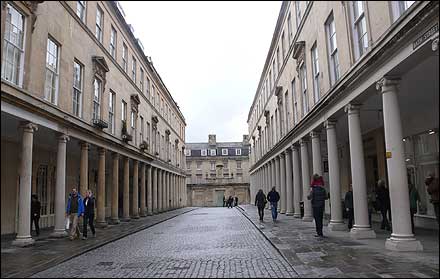
Bath
Bath was a happening resort town during Georgian Era or the period when the Georges were on the throne of England. For those who remember dates, that’s 1714-1830. The architecture has remained surprisingly unaltered through time and is an excellent example of the period. I’m lousy with architectural history, but from what I understand Georgian design is obsessed with the clean lines and mathematical precision of classicism. The understated style is sandwiched between the more bombastic Baroque and Victorian.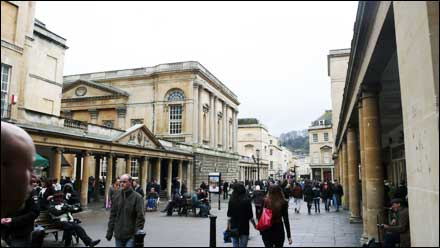
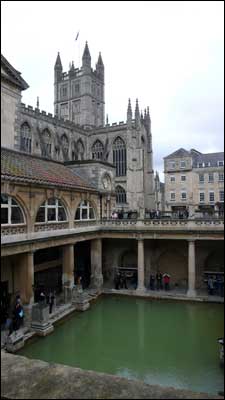
Aqueas Sulis
There are two stories explaining the origins of Bath. In the first, King Bladud created the springs through divination. He went on to build feathered wings for himself, but sadly died flying into the Temple of Appollo in New Troy. Bummer. In the second story, Bladud became afflicted with leprosy and left the court to become a swineherder. He and his pigs, also stricken with leprosy, found the springs and were cured. Bladud returned to court, became king, and fathered King Lear. Regardless, there was an early Celtic shrine erected at the springs dedicated to the goddess Sulis. Later the Romans would appear on the scene and build “Aqueas Sulis” proper, though they identified Sulis as the goddess Minerva.
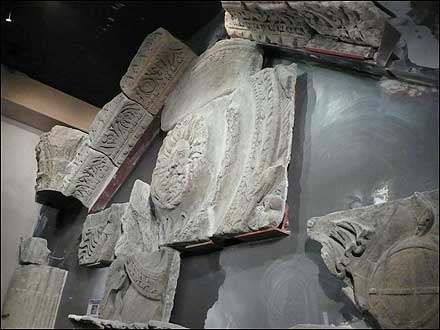
Ruins from the Roman Temple
After the Romans, things slide right into the dismal Middle Ages where everyone managed to forget that the earth was round and went around the sun, or how to make flush toilets, or build decent roads.
Nonetheless, rumor had it the springs had curative powers, and ailing people from all over England continued to come and swim or drink the waters. What you see today was built in the eighteenth century.
The museum takes you into the archeological diggings of the Roman Bath temple and chambers including the hot, cold, and warm baths. There a bunch of stone stuff to Minerva, but I’ve never “ohh-ed and ahh-ed” over Roman art. It’s the Roman drain still holding runoff from the springs that fascinates me or the stone piles that held up the floor to allow hot vapor to build up underneath. What happens when geeks travel…
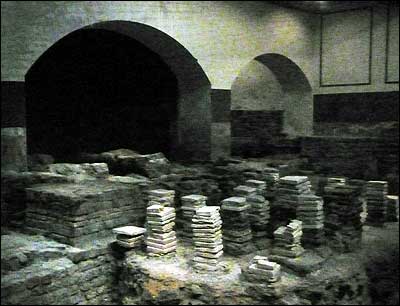
Heated Roman Floor
Here is a virtual tour of the Baths
We actually began the day at the Jane Austen Museum where we listened to a great lecture on Jane’s family, which I can hardly remember as I write. That short term just can't seem to make the haul to long term anymore. Must be mad cow kicking in.
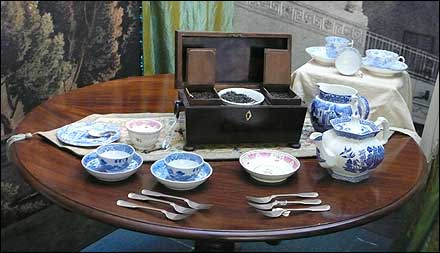
Tea Service
Here is what I remember from the lecture:
Jane had a love, but mostly hate relationship with Bath. She was a nasty critic of its society. Her family removed to the resort city from the country. Unfortunately, the Austen family overextended themselves and had to give up their first finer home in Bath. Over time, they slipped slowly down through the cracks of society until the final blow of Mr. Austen’s death, leaving the females in the family in financial straits. Jane’s brothers came to their rescue and set up the women on a country home. Unlike the Brontes, the male Austens were generally decent people.
Though several of her novels were set in Bath, Jane did not write much while living in the town. The novels that we read today were either written or rewritten from earlier novels at Jane’s home in the country.
Here is a neat sign explaining how people lived in Jane’s time based on their income level.
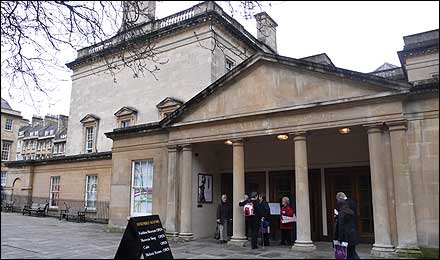
The Assembly Rooms
The Assembly rooms were bombed in WWII. What you see today is a careful restoration. Up until the Prince Regent built the Royal Pavilion in Brighton in the early nineteenth Century, Bath was the most popular resort town in England. People came in from nearby Bristol, London, and the countryside to rent a house for the season. All levels of society mingled in Bath, thanks to big-man-about-town Richard Beau Nash. He laid down “rules” of behavior for Bath, which excluded all sorts of lovely pursuits such as dueling with swords, cock-fighting, or bull-baiting.
Nash’s rules are pretty humorous, so I will include them.
I. That a visit of ceremony at coming to Bath, and another at going away, is all that is expected or desired by ladies of quality and fashion - except impertinents.
II. That ladies coming to the ball appoint a time for their footmen's coming to wait on them home, to prevent disturbances and inconveniences to themselves and others.
III. That gentlemen of fashion never appearing in a morning before the ladies in gowns and caps, shew breeding and respect.
IV. That no person take it ill that any one goes to another's play or breakfast, and not to theirís - except captious by nature.
V. That no gentleman give his tickets for the balls to any but gentlewomen - N.B. Unless he has none of his acquaintance.
VI. That gentlemen crowding before ladies at the ball, shew ill-manners; and that none do so for the future- except such as respect nobody but themselves.
VII. That no gentlemen of lady take it ill that another dances before them - except such as have no pretence to dance at all.
VIII. That the elder ladies and children be contented with a second bench at the ball, as being past or not come to perfection.
IX. That the younger ladies take notice how many eyes observe them - N.B. This does not extend to the Have-at-Alls.
X. That all whispers of lies and scandal be taken for their authors.
XI. That all repeaters of such lies and scandal be shunned by all company - except such as have been guilty of the same crime.
N.B. Several men of no character, old women and young ones of questioned reputation, are great authors of lies in the place, being of the sect of Levellers.
In the winter months or “season,” people bought subscriptions to attend activities at the Assembly Rooms. On Monday’s there was a Dress Ball which cost a guinea for three tickets. It started at six o’clock. For the first two hours, stately minuets were danced, followed by some get-down country dances lasting until nine. Then everyone went to Tea Room for refreshments of sweet meats, jellies, wine, biscuits, cold ham, turkey, tea with arrack and lemon. Concerts were held on Wednesday. Musical guests included Joseph Haydn and Franz Liszt. Cotillion balls or country dances occurred on Thursdays. Cards could be played every day. Gambling was an addiction in that period and lots of pounds were laid down on Whist, a precursor to Bridge and Spades, and Vingt-et-Une (blackjack).
Sadly, in the early nineteenth century, society followed the Prince to Brighton and the Assembly Rooms fell into decline, becoming a cinema in the 1920s.
I couldn’t get good pictures of the room because there were portable chairs stacked about. So I would suggest the Assemble Room virtual tour.
Housed beside the Assemble Rooms, is the tres cool Bath Costume Museum. However, if you want to see some awesome costumes, you gotta go to the Victoria and Albert museum in London.
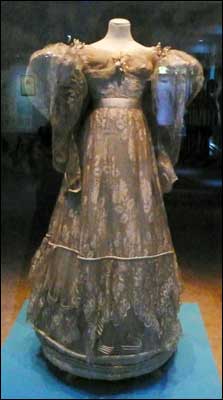
This dress is from approximately 1830 because of the slightly lowered waistline.
From the Assemble rooms, we hot-footed it over to No 1. Royal Crescent. Crescents are big thing in Georgian England.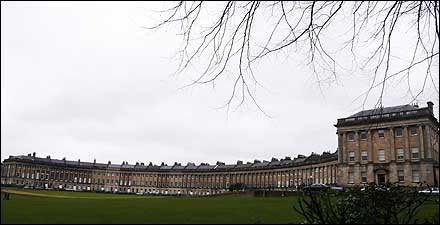
Royal Crescent
No. 1 Royal Crescent is a museum of the typical Bath home in the Georgian era. Unfortunately, the museum wouldn’t indulge my photo obsession, which prompts me to mention my other fixation: guidebooks. I feel like a set designer when I visit these homes. What did it look like, what did it feel like, how would one move in the space? I get nothing from the sterile environment of museums where artifacts are kept under glass. I want contextualization, silence, and time. Once my mother let me in a house that was about to be given to the Georgia Historical Society. The place hadn’t been altered since the turn of the century. It was like a playground to me, wandering through the rooms, like the quiet human observing the ghosts.
The Bath homes were row houses that extended up five or more stories from basement. Under the entrance walkway would be the coal vault, behind it an open area that led to the kitchen. On the iron fences above would be a rigged pulley or winch that allowed supplies to be lowered to the kitchens below. The basement level contained the kitchen rooms with a large fireplace and spit, servant’s table, and an additional vault for storing wine and beer. Some feet behind that vault wall was the cesspit that accepted the drainage from the outdoor privy running above it. Liquid matter in the cesspits was supposed to seep into the ground. Cesspits were emptied by the night soil men who came around early in the morning or by the poor servants who would have to haul the waste, bucket by bucket, through the house. They may have dumped the contents into the sewer opening in the front of the house which was technically illegal. These sewage passages were made of brick and did not have a constant flow of water to push the contents along.
The first floor (Americans add one floor) opened to a central hall flanked by parlors or a dining room. The dining room could be on first or second floor. In this house, the stairway zigzagged up the back wall of the house with another circular servant’s stairway on the side of the house. In other homes, the staircase emptied into the central hall, not a few feet from the front door.
Aside from the parlor downstairs, on the second floor there could be a withdrawing or drawing room, study, male or female parlor. Bedrooms made up the three floor and the children and servants stayed on the attic floor. Every room had a chimney and corresponding chimney pot belching coal smoke and soot into the sky.
Water as supplied to a lead cistern in the kitchen. It came to the house through narrow lead pipes which feed from larger pipes made of hollowed out elm trunks. Bath had a consistent supply of water because it tapped the natural springs in the area. Water companies were private. In London, where the water supply was not always constant, a house could have water supplied by multiple companies. Typically, water was serviced only to the ground floor. Inside the house, people could use a chamber pot or if they were lucky they had a water closet which was created either by a tank or pump forcing water up in a pipe leading from the cistern in the basement.
The entrance way would include a foot scrape, iron lamp bracket for holding the torches that the city required be burned at night during the winter months, a fire insurance plaque so the private firefighters knew to put out a fire at the home, and a snuffer for extinguishing torches.
Afterwards we strolled through the lovely parks and not so lovely parking lots until we reached the unassuming row house once belonging to famed astronomers, William Herschel and his sister Caroline Herschel. William Herschel is credited for using his telescopes to find Uranus, and the moons Titania and Oberon. Caroline is famous for finding several comets, a nebulae, and for putting up with her brother.
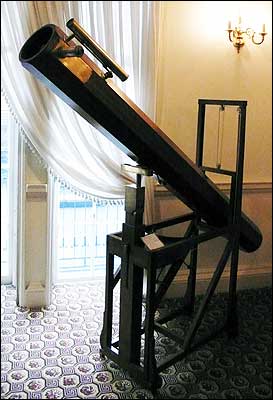
Replica of Herschel's Seven Foot Newtonian Reflecting Telescope. He used the original to find Uranus in 1781.

Model of Herschel's Forty Foot Telescope
William, born in Hannover, started his professional career as a composer. Unfortunately he wasn’t so well–received. In fact, he had to publish a public apology in Bristol newspaper concerning his horrific performance of “The Messiah.”
Poor pox scarred Caroline was left behind in Hannover to be a housekeeper to her family. She joined William when he came to Bath. He taught her English and gave her music lessons. Often she assumed the role of lead singer in his choral works. (Caroline probably had more promising in a musical career than her brother, but she declined the opportunities presented to her.) William considered astronomy a mere hobby. Unfortunately he couldn’t afford a nice, new shiny, telescope, so he decided to build one. And that’s when all hell broke loose. Building telescopes became his passion. Caroline writes, “It was my sorrow that I saw almost every room in the house turned into a workshop.” Keep in mind, William used horse poo-poo to make molds for his lens.
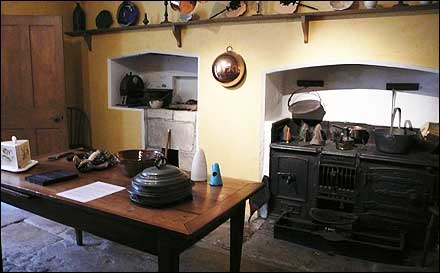
Herschel's Kitchen.
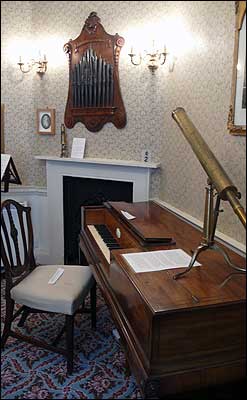
Music Room
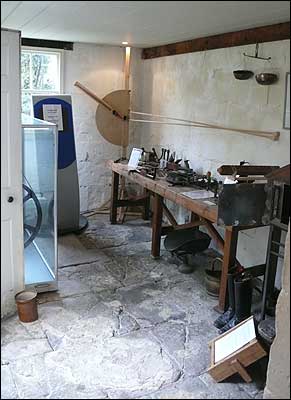
Herschel's Tiny Workroom at the very back of the house.
It was in this garden that in 1781 Hershel discovered Uranus.
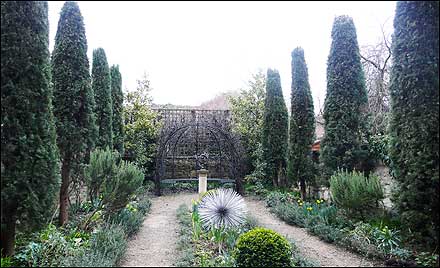
It was getting close to time to meet N and the children. Mom and I swung into the Sally Lunn house, reputedly the oldest house in Bath, circa 1482. It’s a restaurant, but in the basement is a tiny museum to Sally Lunn’s kitchen. Sally Lunn was a French Hugueno who came to Bath in 1680. She became famous for her bread buns.
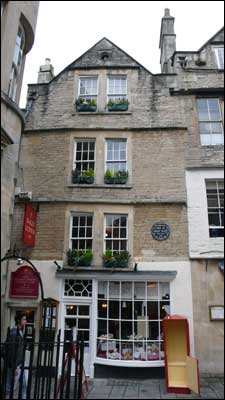
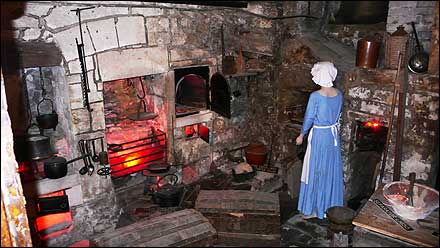
Sally Lunn Kitchen Museum
And then ten minutes in the Bath Abbey.
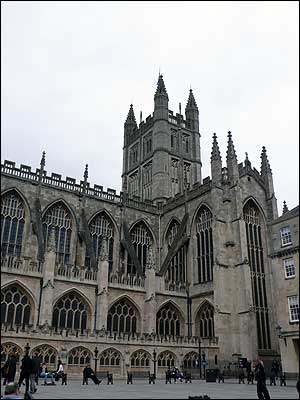
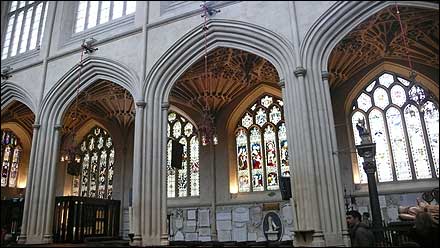
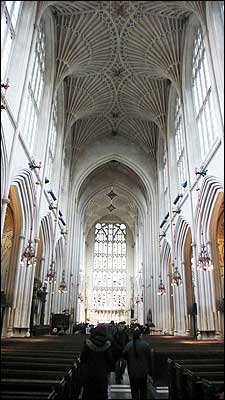
One minute at the chocolatier and onto London!
Thursday, January 20, 2011
The Sexy Bustle

As a woman, I have no desire to wear a bustle. I haven’t figured out how they ever sat down in the contraption. But, as a writer, I love to have my historical heroines decked out in beautiful clothes and my heroine, Darcy, in Almost An Outlaw, wears bustles. Poor dear!
Sunday, January 16, 2011
Juicy Bits of Agony
So...how do you get your ideas?
If we're talking historicals (and of course we are!), Regencies and Victorian romances, specifically, there's a treasure trove of tantalizing tidbits I stumbled across recently that cannot fail to fire your imagination and fill you with inspiration. (Unless your heart no longer beats, which is another story entirely and, in which case, perhaps you should be delving into paranormals.)
Apparently, back in the days of yore (and perhaps still for all I know), The Times (that'd be the London Times), ran a newspaper feature somewhat similar to the classified ads and personals of today. This second column became known as "The Agony" because it was chock-o-block with titillating scandal, the woes of star-crossed lovers, secret babies, financial ruin, family skeletons, trysts galore, prodigal sons and daughers and illicit romances. In 1881, some of the juiciest of these were collected by a lady named Alice Clay and published by Chatto & Windus, Piccadilly.
I herewith give you some additional entries:
Monday, January 13, 1800.
THE ANSWER of a LETTER to an OFFICER at HEREFORD is, "That he Was."
Thursday, December 18, 1800.
A CARD -- If the Lady who a Gentleman handed into her carriage from Covent Garden Theatre, on Wednesday, the third of this month, will oblige the Advertiser with a line to Z. Z., Spring Garden Coffee House, saying if married or single, she will quiet the mind of a young Nobleman, who has tried, in vain to find the Lady. The carriage was ordered to Bond Street. The Lady may depend upon honour and secrecy. Nothing but the most honourable interview is intended. The Lady was in mourning, and sufficiently cloathed to distinguish her for possessing every virtue and charm that man could desire in a female that he would make choice of for a Wife. Deception will be detected, as the Lady's person can never be forgot.
E
Saturday, June 16, 1804.
TO MAME. "Forget" you? By Heaven I cannot! Engraven on my soul is your memory, in deepest characters, which time vainly will endeavour to efface, contracted as now must be its span, since without one remonstrance, one expostulation, you can resolve for ever to forget me. Wherefore, then, often warned, persist in exciting a reluctant, indeed, but never more unfeigned, sensibility only to wound it? DO I DESERVE THIS? Is it generous? Is it equitable? But severe no longer, welcome now, is the mandate of authority, enjoining oblivion of
ORL O.
Friday, September 21, 1804
IF the YOUTH THAT LEFT ISLINGTON on Sunday evening can remember that he ever had a Mother, he is informed he will soon be deprived of that blessing, except he immediately writes particulars, or personally appears before her. His friend will redress any circumstance, and settle every point to his satisfaction.
Thursday, September 21, 1820
H begs leave to acknowledge receipt of J.A.'s communication, and to inform him, that he need not hesitate in naming the harbour and using his own oars.
Saturday, November 6, 1824
JOE to JACK -- SURRENDER!
Now, I admit I did not get the germ of the idea for Healing Hearts, my February 28 Carina Press release, from any of these. But I am suddenly seized with all sorts of possibilities. I imagine Emma's Times notice to Adam might have gone something like this:
IF the noble Gentleman responsible for the death of a Young Lady's twin brother on the Peninsula still feels any attachment to the Family that held him in esteem as a Youth, he should call upon them in the Country at once, as they are in dire straits. ~ E
Thursday, January 13, 2011
The Most Disreputable Flower
Sunday, January 09, 2011
Very Superstitious...
Oh, I have a few rituals, especially when it comes to watching sports. When my Auburn Tigers play for the national championship tomorrow evening, I’ll be in the same chair in the den where I’ve watched all their televised games this year. Why shake things up by sitting on the couch when the chair has worked so well so far? And every time Felix Hernandez of the Mariners flirts with a no-hitter, I studiously observe the rules about not actually SAYING “no-hitter.” The closest I’ve come is to hint that my husband might want to come downstairs and watch the game, because Felix is pitching REALLY WELL. The fact that so far the closest Felix has come is a couple of one-hitters surely isn’t because the superstition is meaningless, but because of all those OTHER people talking about it openly.
Do I really believe my choice of chair impacts Cam Newton’s passing efficiency or my avoidance of “no-hitter” actually makes King Felix’s curve ball any tougher to hit? No, not really. My rituals just make me feel like a tiny bit of a participant in my teams’ success.
But when I had a run of bad days right around Jan. 1, which also happens to be my birthday, I found myself thinking, “This just doesn’t seem like a good sign. Does this mean 2011 is going to be all about being kinda sick and wrestling with minor but annoying personal setbacks and bureaucratic glitches?” At the time it didn’t even occur to me that I never would’ve taken the same events in, say, mid-May, as a sign the next 365 days were going to be bad ones.
You’re probably wondering what any of this has to do with history. I’m getting there, I promise. Eventually I got over my bad cold and moved past the setbacks and glitches, but I still had a niggling feeling that 2011 was just NOT looking all that good for me.

Then last week I was reading Napoleon: The Final Verdict as part of a research reading challenge I set myself. One of the authors mentioned how Napoleon was fond of omens, e.g. liking to fight a battle on the anniversary of a previous victory. I thought, “That’s incredible, that a man as intelligent and rational as Napoleon could at the same time be so superstitious and illogical.”
Then a voice in the back of my head, one that sounded a little like I imagine Napoleon must have sounded said, “What’s that? Aren’t you the one who’s been covered in gloom because you weren’t happy on your birthday/New Year’s Day, even though you too consider yourself intelligent and rational?”
OK. Imaginary Napoleon has a point. 2011 may be good or bad, but it hasn’t been determined already by a few annoying days in early January. And every once in awhile the lessons history teaches me aren’t the ones I expect to learn.
What about you? What unexpected lessons have you learned from history? And what are your superstitions?
-----
Susanna Fraser writes Regency romance with a focus on the Napoleonic Wars. The Sergeant's Lady is available now from Carina press, and its prequel, A Marriage of Inconvenience, will be released April 11.
Wednesday, January 05, 2011
History of Men's Underwear - Part One!
By Erastes
Being a writer of Gay Historical Fiction, I find I have to research the subject of what was worn under the overclothes pretty often.
This reminds me of the old joke:
Woman: (to Scottish soldier) Tell me, Sargeant, is anything worn under the kilt?
Scottish Soldier: No, ma'am. It's all in perfect working order!
So I thought you might like to share in my researches in this fascinating study!
Loincloths might still be around (roll on global warming) but they have been found in burial sites on the bodies of men living over 7000 years ago. Who knows what sparked man to start covering his bits – it would hardly be warmth, after all. It would offer some level of protection from thistles I suppose, but not if a sabre toothed-tiger was coming at you at groin level.
Tutankhamen was buried with 145 loincloths. This seems either a lot, or not enough, depending on your point of view of how long the afterlife is going to be. Of course by this time, the loincloth was worn under a skirt. Still – roll on global warming.
The Ancient Greeks obviously didn't have to worry about sabre-toothed tigers, and consequently didn't wear any underwear at all. Good for them! Φοβάμαι τους Έλληνες όταν είναι πηγαίνοντας καταδρομέας!**
The Romans did, though – big sissies. Possibly because their empire stretched into chillier areas. They'd wear something called a subligaculum, which in modern terms means a pair of shorts or a loincloth and was worn under a toga or tunic.
Oh yes, I know - probably NOT an accurate picture of underwear but is anyone complaining I'm showing this picture from a recently restored version of Spartacus?
Pull on undergarments were invented around the 13th century, large baggy drawers called "braies" made from linen were worn by men under their clothes. This style of undergarment did not really change in design for 500 years, other than to be fashioned from better, finer fabrics and to have ornamentation.
They shrank considerable during the Renaissance as the familiar image of cod-piece and hose emerged. The hose themselves were an open garment – not like our tights or hose of today.
Tight on the legs and open at the front and back which could not be worn openly as the privities hung lose. As the doublet became shorter somthing else was needed! The braies shrank to show off the hose, and the codpiece was developed to protect the wearer's modesty.
Or at least at first.
Gradually the codpiece evolved, became padded, shaped to fit and as some clearly showed were frankly showing off- and obviously exaggerating. Some of the most "impressive"are those belonging to Henry 8th and shown at the Tower of London, where other Crown Jewels are protected too!!
What is interesting is that the fashion of today – that of showing off one's designer underwear, is not a new thing at all. The rich would commission the most exquisite undershirts,and underwear- fabulously expensive fabrics and meticulously embroidered. Why, they reasoned, am I paying for such incredible work that will never be seen? This led to the "slashing" fashions that we see in the Elizabethan period, where the overclothes had slits in- the better to show off the gorgeous clothes being worn beneath.
After these excesses calmed down, and waistcoat shirt and breeches took the place of doublet and hose, men returned to wearing braies or "strossers" – during the English Civil War the only difference between undergarments and overgarments were the weight of the wool they were made from.
**I fear the Greeks going commando
Next time - from 1700 to the mid 20th century.
Erastes writes gay historicals, and her first book for Carina is "Muffled Drum" (set during the Austro Prussian War) and will be out in July 2011. It's full of soldiers, horses, angsty love and many many buttons.











